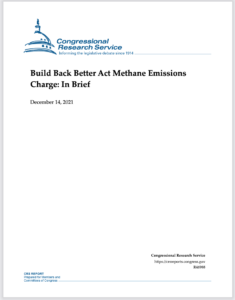Full Title: Build Back Better Act Methane Emissions Charge: In Brief
Author(s): Jonathan L. Ramseur
Publisher(s): Congressional Research Service (CRS)
Publication Date: December 14, 2021
Full Text: Download Resource
Description (excerpt):
On November 19, 2021, the House passed the Build Back Better Act (H.R. 5376, also referred to
as the budget reconciliation bill). Among other provisions, the bill includes a charge on methane emissions from selected entities in the oil and gas industry.1 The charge would apply only to methane emissions from specific types of facilities that are required to report their greenhouse gas (GHG) emissions to the Environmental Protection Agency’s (EPA’s) Greenhouse Gas Emissions Reporting Program (GHGRP). The charge would start at $900 per metric ton of methane, increasing to $1,500 after two years, which equates to $36 and $60 per metric ton of carbon dioxide equivalent, respectively. If enacted, this charge would be the first time the federal government would directly impose a charge, fee, or tax on GHG emissions.
In recent months, the methane charge proposal has received considerable attention from Members and a range of stakeholders. According to some analyses, the methane charge would account for a considerable percentage of the estimated GHG reductions that could be achieved by the Build Back Better Act. Some groups have raised concerns about economic impacts resulting from the methane charge, including impacts on natural gas prices. Some policymakers are concerned about the charge in the context of EPA’s proposed regulations to address methane emissions from the same categories of new and existing facilities that would be subject to the methane charge.
This report discusses the scope and applicability of the Build Back Better Act methane charge. The first section of this report provides background about methane emissions in the United States. The second section discusses the scope and applicability of the methane charge and its rate structure. The last section includes selected factors that may play a role in affecting the scope of the charge and its potential impacts
